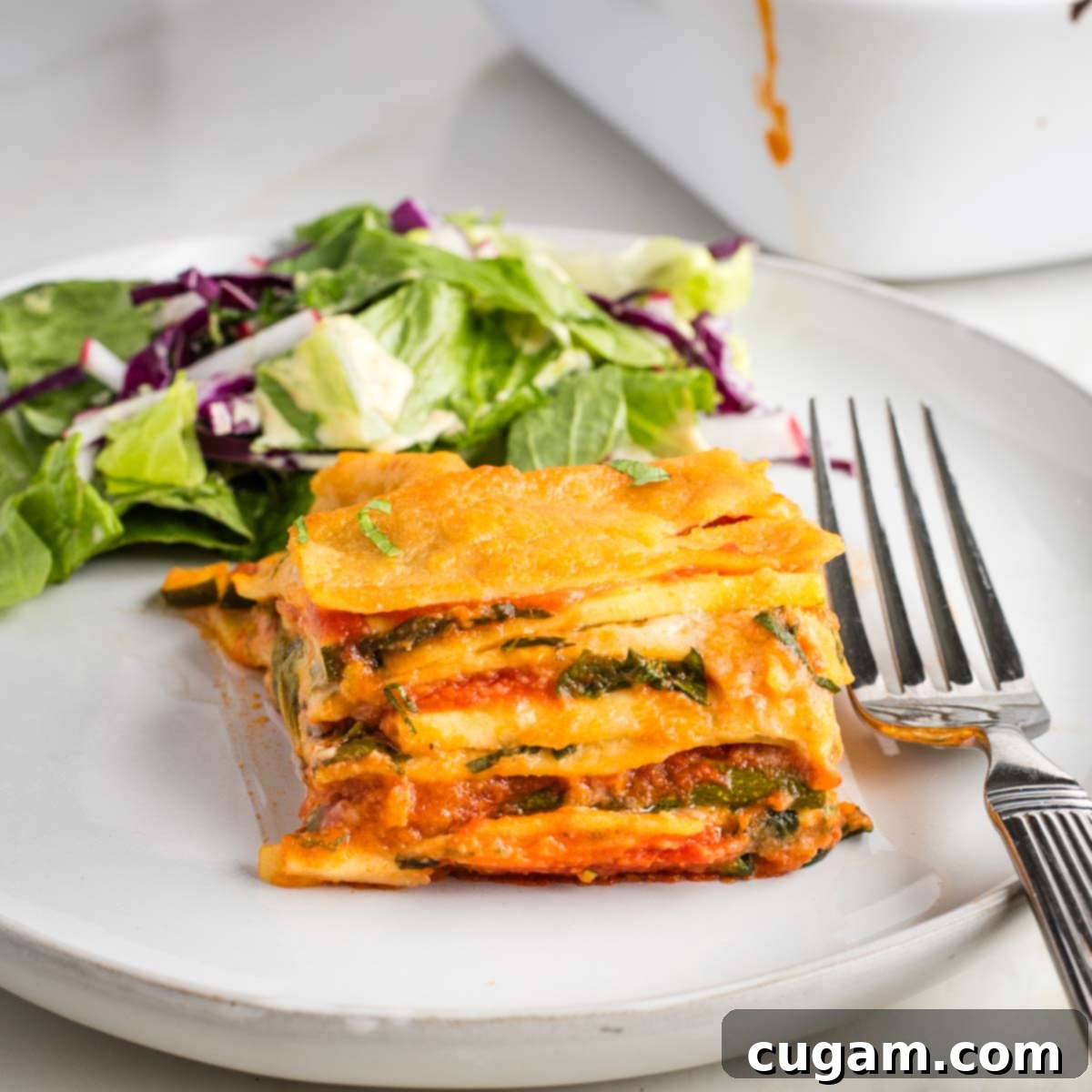The Ultimate Vegan & Gluten-Free Lasagna with Creamy Dairy-Free Bechamel
Discover the secret to a truly delightful and wholesome meal with this incredible Vegan Lasagna recipe. What makes it stand out is its rich, homemade gluten-free and dairy-free bechamel sauce, meticulously layered between tender sheets of gluten-free pasta, vibrant marinara, fresh spinach, and thinly sliced zucchini. This isn’t just a meal; it’s a culinary experience – hearty and deeply satisfying, yet surprisingly light and incredibly nutritious. Prepare to say “Winner, winner, healthy vegetable lasagna for dinner!” as this dish effortlessly combines comfort food indulgence with nourishing, plant-based goodness.
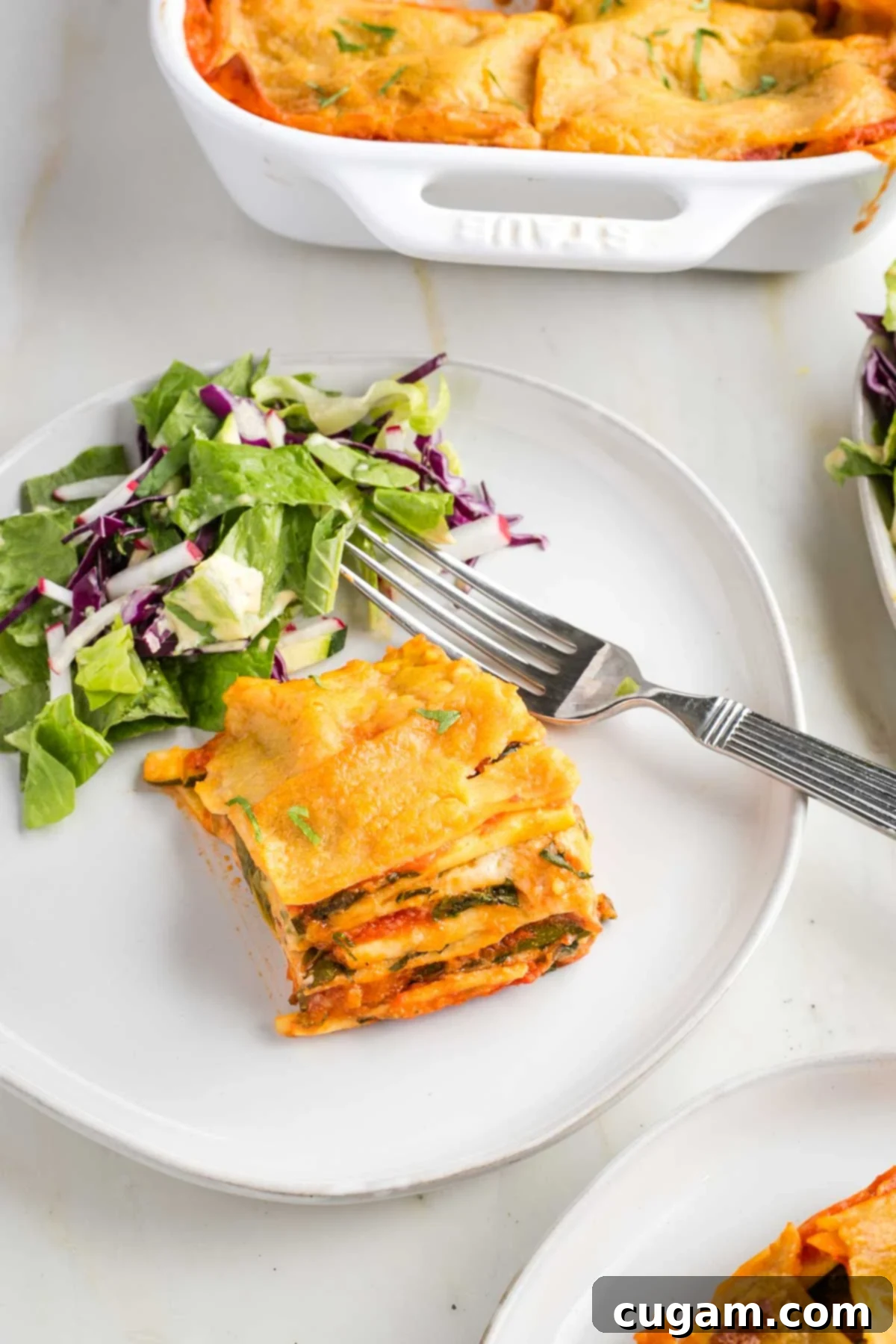
[feast_advanced_jump_to]
Why You’ll Fall in Love with This Vegan Lasagna Recipe
This vegan and gluten-free lasagna isn’t just a recipe; it’s a revelation. Here’s why it quickly became a staple in my kitchen and why I’m confident it will become a favorite in yours too:
- A Complete Meal in One Dish: Forget juggling multiple pots and pans! This lasagna offers a perfectly balanced, wholesome meal all by itself. It’s packed with vegetables, protein from the nutritional yeast and cashew milk, and satisfying carbs from the pasta. While you can certainly complement it with a simple side salad or a roasted veggie side dish, it’s absolutely not necessary. This dish is robust enough to stand alone, making weeknight dinners or meal prep a breeze.
- Effortlessly Easy to Assemble: Don’t let the layers intimidate you! This recipe is designed for simplicity. Even after the most demanding day, you’ll find it surprisingly easy to layer and get into the oven. The key is minimal pre-cooking (no need to boil the lasagna noodles!) and a well-prepped bechamel, which can even be made in advance. This means less stress and more time to enjoy the process and the delicious results.
- Inclusive for All Dietary Needs: One of the greatest joys of this lasagna is its universal appeal. It’s both **vegan and gluten-free**, meaning you don’t have to prepare separate meals for family members or guests with different dietary preferences or restrictions. Not only *can* everyone enjoy it, but even those who typically eat meat and cheese rave about the rich flavors and satisfying texture of this delightful plant-based lasagna. It truly brings everyone to the table!
- Umami-Rich, Satisfying, Yet Surprisingly Light: This lasagna is a masterclass in flavor balance. It delivers a deeply savory, umami-packed experience that is incredibly satisfying, fulfilling those comfort food cravings. However, unlike traditional lasagnas that can feel heavy and leave you sluggish, this version remains wonderfully light. It’s perfect for when you’re yearning for a comforting pasta dish without the post-meal heaviness. You’ll feel nourished and energized, not weighed down.
- Versatile for a White Sauce Lasagna Craving: In the mood for something different? This recipe is incredibly adaptable! If you’re craving a pure **vegetable lasagna with white sauce**, simply double up on the dairy-free bechamel and omit the marinara entirely. This easy swap transforms the dish into a fabulously rich and creamy white lasagna, proving its versatility and ensuring delicious results await, no matter your preference.
Crafting the Creamy Dairy-Free Bechamel Sauce
The heart and soul of this vegan lasagna truly lies in its luscious dairy-free bechamel sauce. This creamy white sauce provides the essential richness and binds all the delightful layers together. The best part? It’s surprisingly quick and easy to make, taking only about 10 minutes of active cooking time. For ultimate convenience, you can prepare this bechamel up to 5 days in advance and store it in an airtight container in the refrigerator, ready to go when you assemble your lasagna.
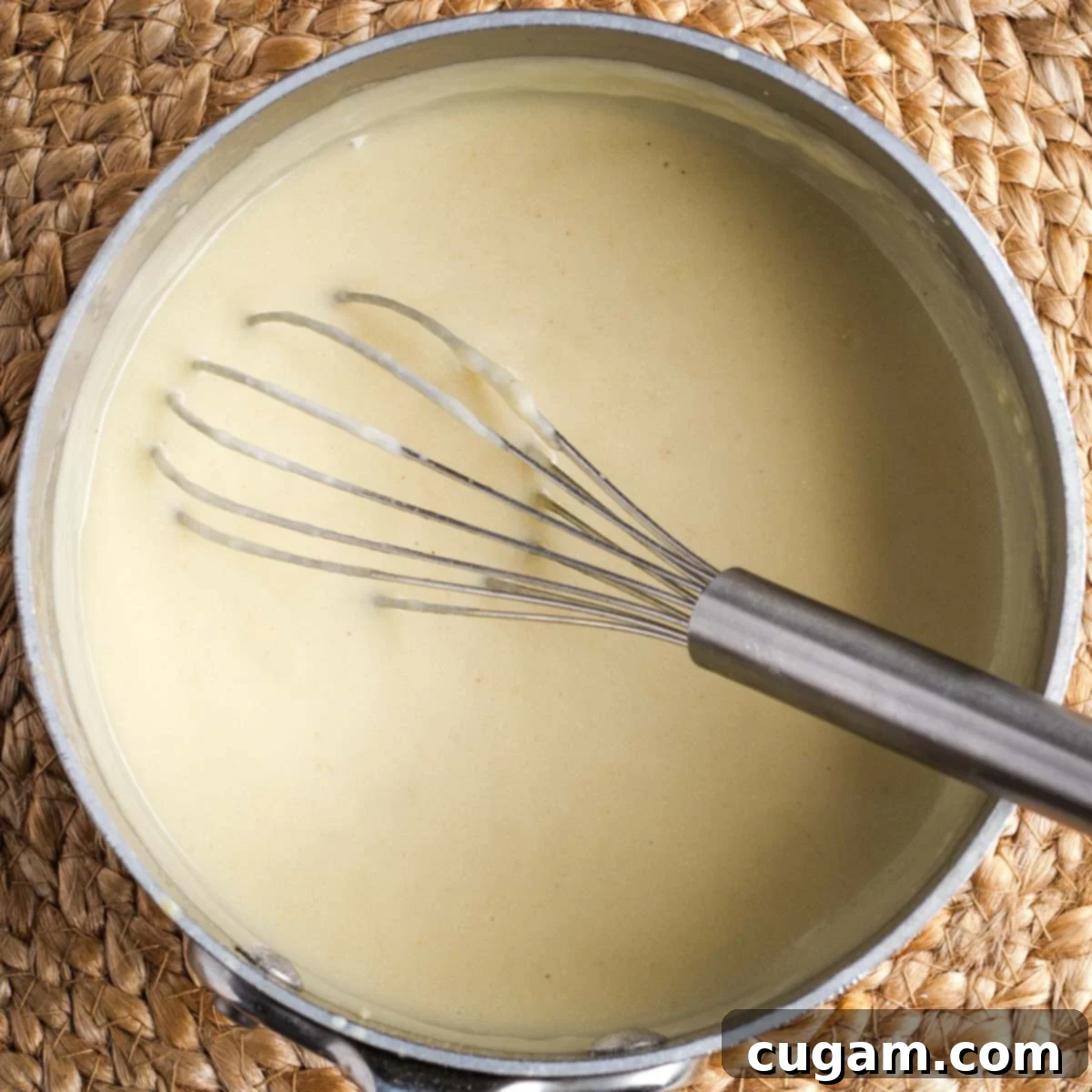
The process starts by creating a classic roux, but with a plant-based twist:
- Begin by gently heating olive oil in a saucepan, then whisk in cassava flour to form a smooth paste. This is your gluten-free roux, the thickening base for the sauce.
- Gradually whisk in cashew milk, a few tablespoons at a time, ensuring each addition is fully incorporated before adding more. This slow and steady approach prevents lumps and creates a silky smooth sauce.
- Season generously with salt, freshly ground black pepper, and a touch of paprika for warmth and subtle flavor.
- Finally, whisk in a tablespoon of miso paste. This secret ingredient is what elevates the bechamel, adding a profound depth of umami that beautifully mimics the savory notes often found in dairy cheese, making the sauce truly irresistible.
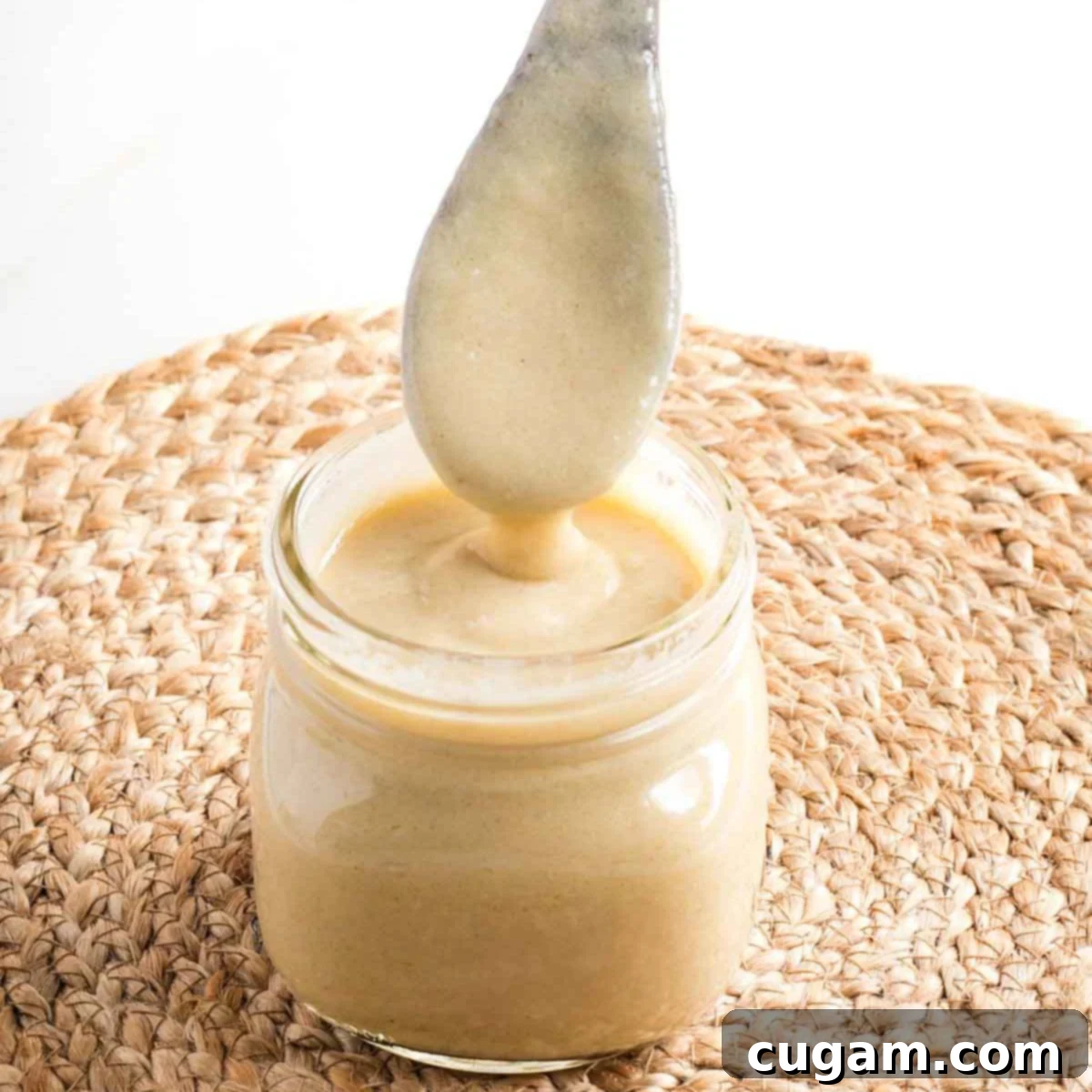
As the bechamel simmers, it will slowly thicken to a wonderfully creamy consistency, coating the back of a spoon. Once cooled, it can be stored in a glass jar in the fridge, ready to transform your lasagna. For more comprehensive, step-by-step instructions and additional substitution tips for this essential sauce, be sure to check out my dedicated vegan bechamel sauce post.
Essential Ingredients & Smart Substitutions for Your Lasagna
Crafting the perfect vegan and gluten-free lasagna starts with selecting high-quality ingredients. Here’s a breakdown of what you’ll need and how you can easily adapt the recipe to your preferences or what you have on hand:
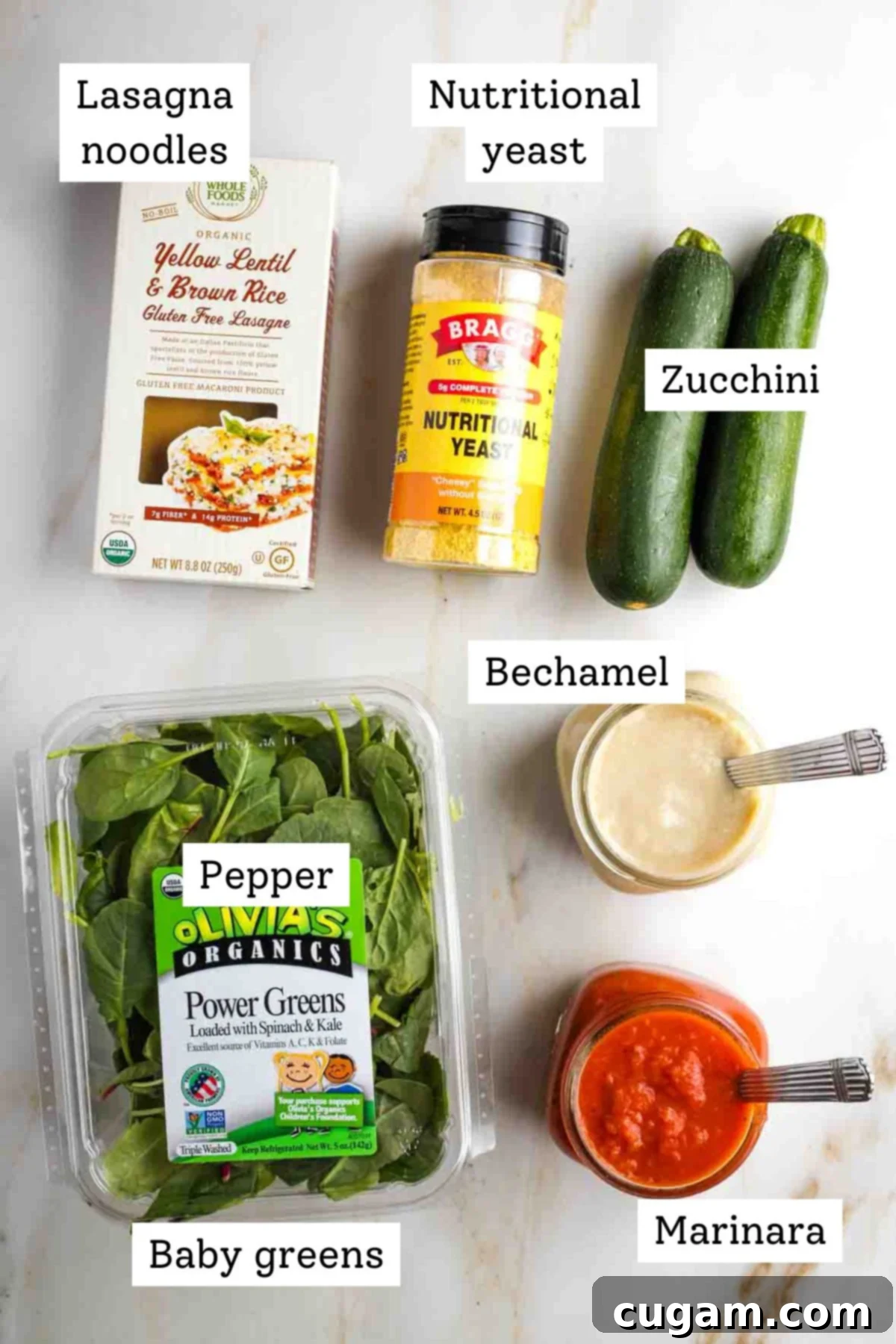
- Gluten-Free Lasagna Noodles: The market now offers excellent gluten-free lasagna noodles that perform beautifully. Select a brand known for its good texture and simple ingredients. Crucially, do NOT cook them in advance, regardless of what the package instructions might suggest. They will cook perfectly to an al dente consistency right in the casserole dish, absorbing the sauces and preventing a mushy texture.
- Fresh Baby Greens: For the green layer, tender baby spinach is fantastic, but feel free to get creative! You can easily substitute with finely chopped baby kale, chard, or a vibrant mixture of any of these leafy greens. They add a wonderful nutritional boost, a touch of color, and wilt down perfectly within the lasagna.
- Zucchini: Thinly sliced zucchini provides a lovely, slightly firm “bite” that mimics the texture of pasta noodles while adding a fresh vegetable component. If zucchini isn’t available or you prefer a different flavor, yellow summer squash is an excellent substitute, offering a similar texture and mild taste.
- Dairy-Free Bechamel Sauce: While my easy homemade recipe for dairy-free bechamel sauce is highly recommended for its flavor and simplicity, you can also use a good quality store-bought vegan white sauce. If opting for a pre-made version, always be sure to carefully read the label to ensure it aligns with your dietary needs and doesn’t contain undesirable processed ingredients.
- Marinara Sauce: A good quality marinara sauce forms the rich red base of this lasagna. For a quick substitute, crushed tomatoes or a plain tomato sauce can work wonders. If using plain tomato products, you might want to add extra seasoning like Italian herbs, garlic powder, and a pinch of sugar to achieve a similar depth of flavor as a well-seasoned marinara.
- Nutritional Yeast:This magical ingredient is your best friend in vegan cooking! It brilliantly imparts a savory, slightly nutty, and distinctly “cheesy” flavor without the need for any dairy or heavily processed dairy-free cheese alternatives. I consciously choose to avoid many store-bought vegan cheeses due to their often long list of processed ingredients, making nutritional yeast my go-to for that umami cheesy depth.
Step-by-Step Guide: Assembling Your Perfect Vegan Lasagna
Once your dairy-free bechamel sauce is ready (whether fresh or prepped ahead), assembling this lasagna is a quick and satisfying process. Here’s how to layer your way to a delicious meal:
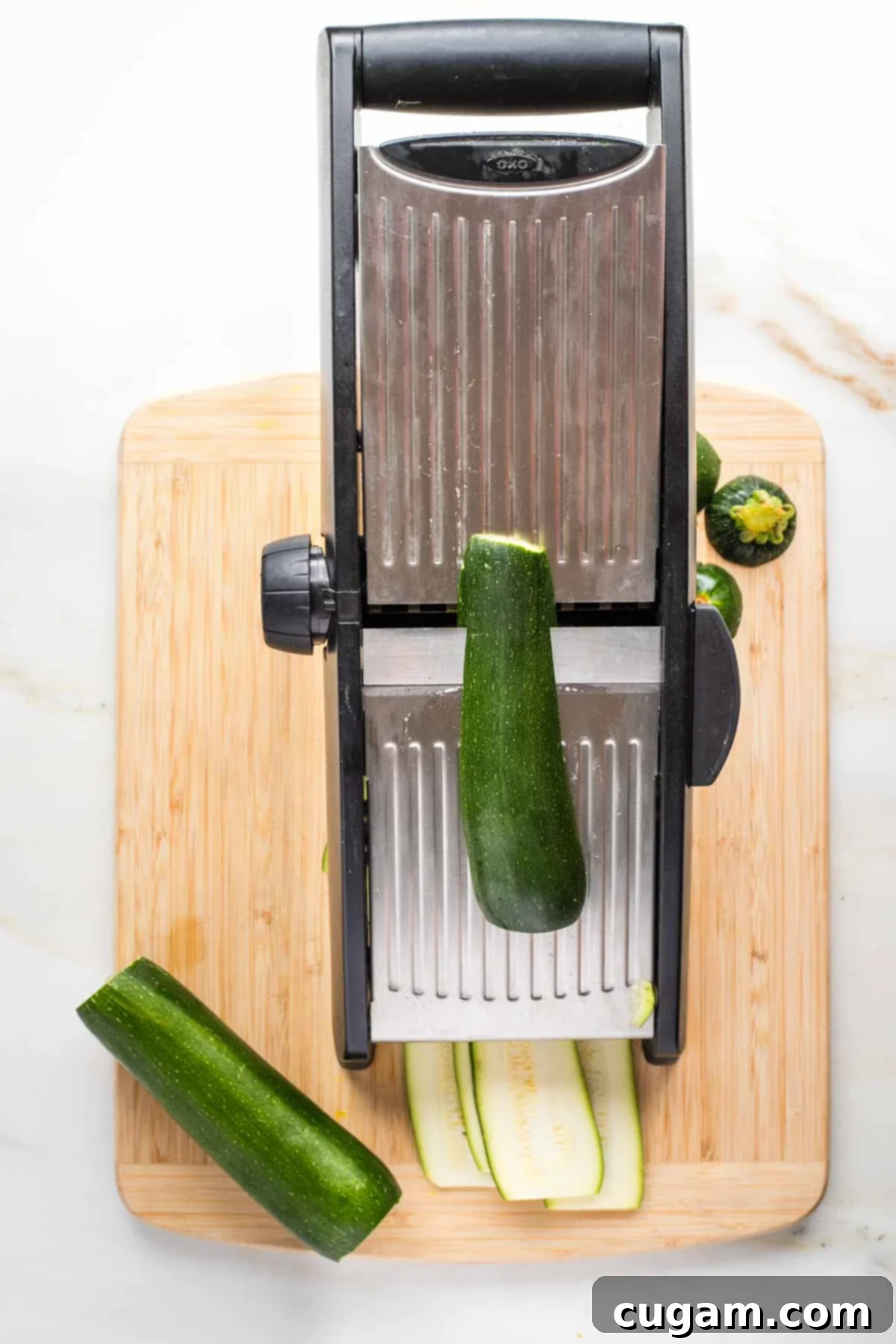
1. Prepare the Zucchini: Begin by prepping your zucchini. For best results and uniform thickness, I highly recommend using a mandoline slicer to cut thin, uniform slices (ideally ⅛-inch thick) lengthwise. These thin slices will beautifully resemble lasagna noodles once baked. If you don’t have a mandoline, a vegetable peeler can also create thin strips, or you can carefully slice them by hand with a sharp knife.
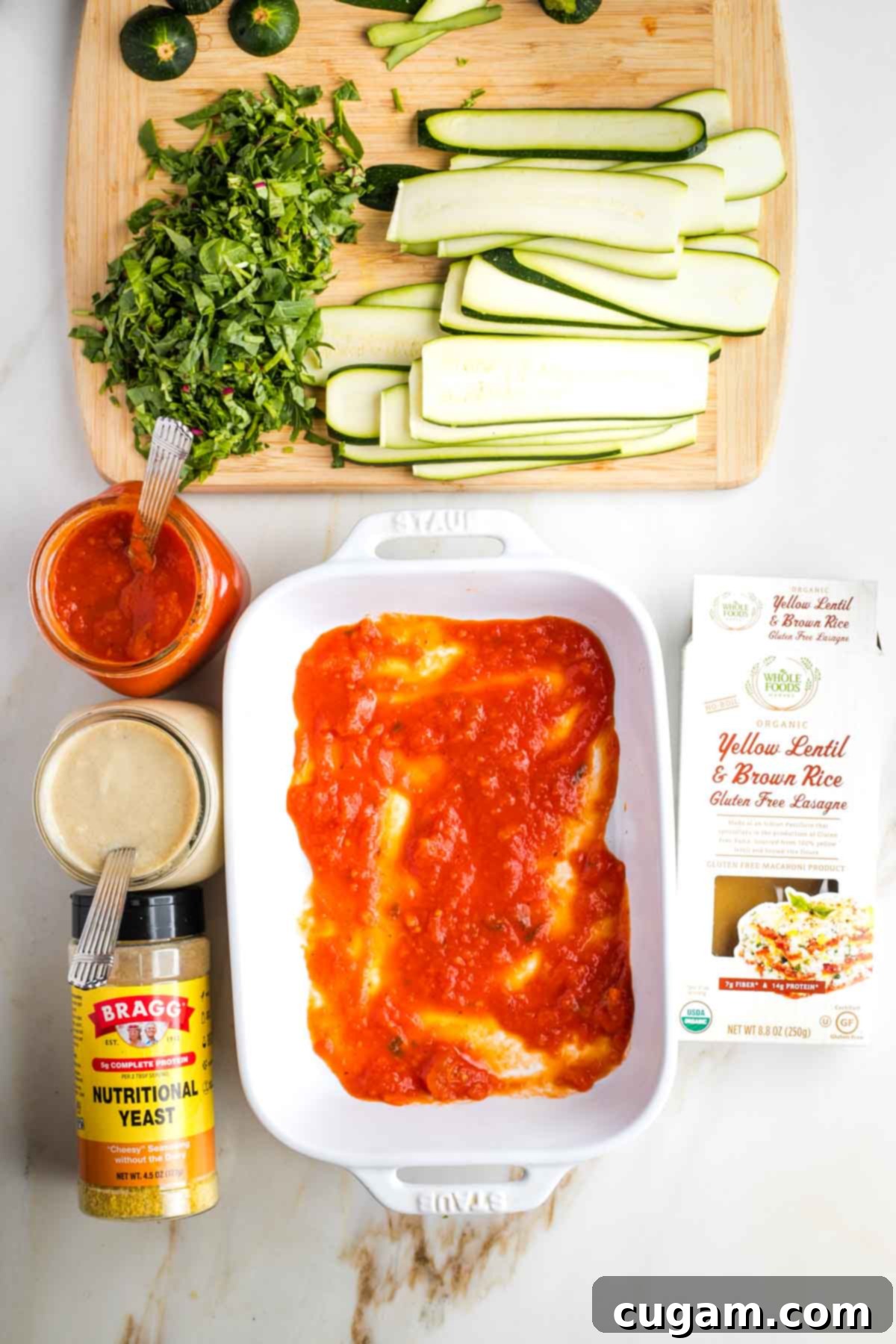
2. Prepare and Arrange: Finely chop your chosen baby greens and then gather all your prepped ingredients: marinara, uncooked lasagna noodles, bechamel, nutritional yeast, chopped greens, and sliced zucchini. Lay them out for easy access. This “mise en place” approach will make the layering process incredibly smooth and efficient. Have your 2-quart baking dish ready.
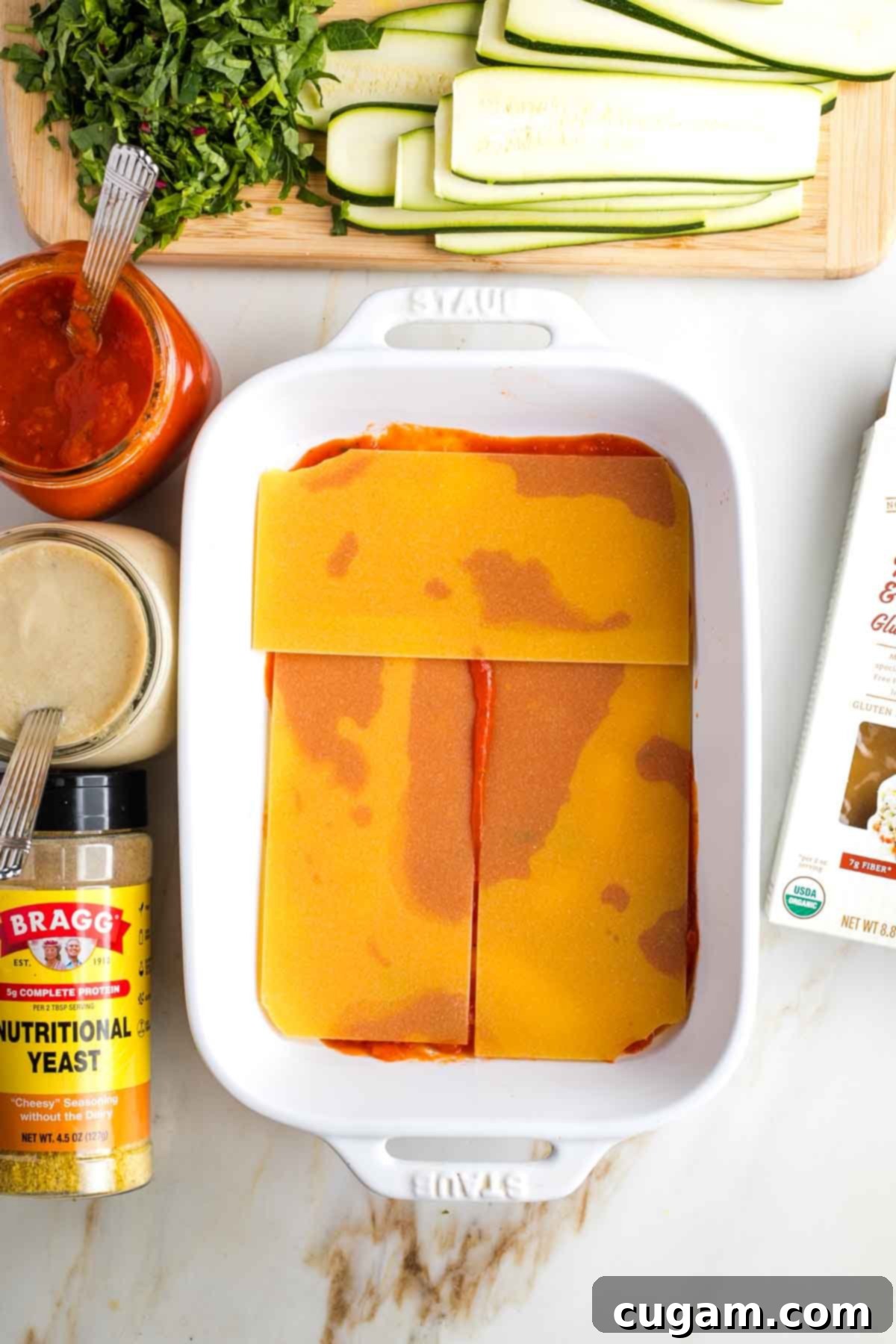
3. Start with Marinara & Noodles: Spoon about ½ cup of marinara sauce onto the very bottom of your baking pan. This not only adds flavor but also helps prevent sticking and provides moisture for the first layer of noodles. Carefully cover the marinara with a single layer of uncooked gluten-free lasagna noodles. If your baking dish has rounded corners, you might need to use kitchen scissors to trim the pasta sheets slightly for a perfect fit.
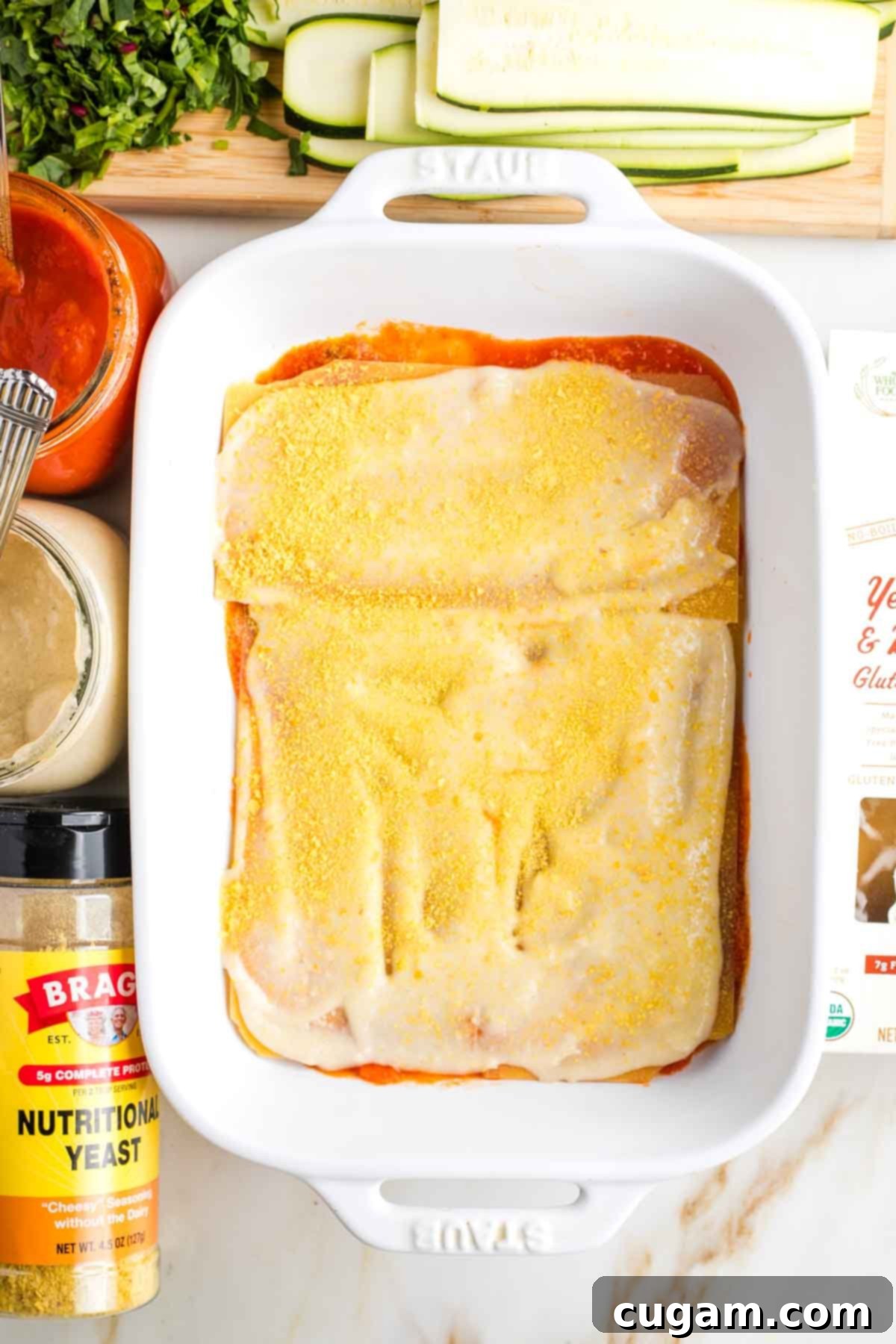
4. Add Bechamel & Nutritional Yeast: Next, spoon about ½ cup of your creamy dairy-free bechamel sauce evenly over the lasagna noodles. Use an offset spatula or the back of a spoon to gently spread it into a thin, uniform layer. This creates a beautifully rich and moist middle. Then, generously sprinkle a portion of the nutritional yeast over the bechamel. This will melt into the sauce, providing that characteristic cheesy flavor.
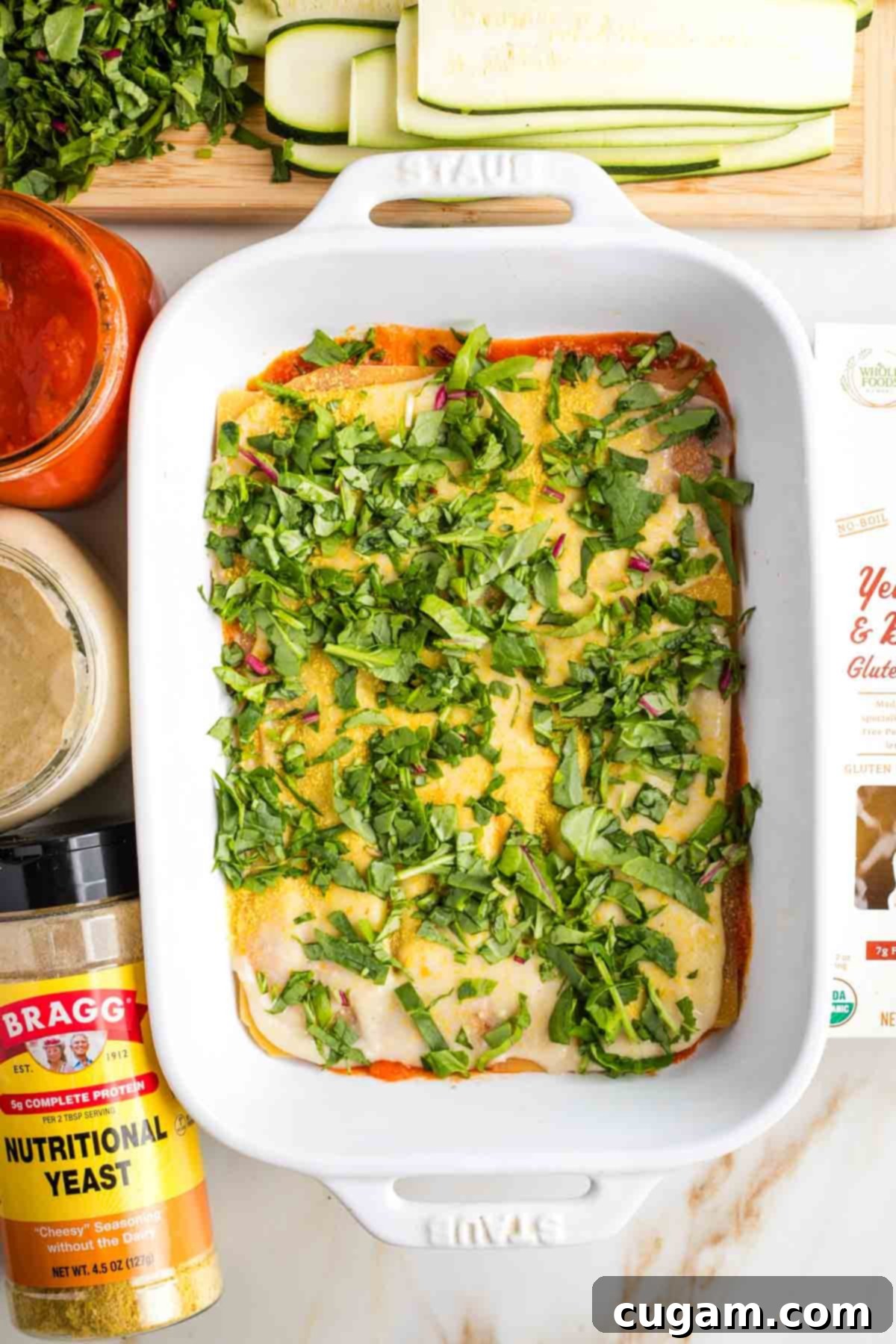
5. Layer with Greens: Now, add a vibrant layer of chopped greens. Evenly sprinkle about ½ cup of your finely chopped baby spinach, kale, or chard over the nutritional yeast layer. This not only adds essential nutrients and color but also a fresh contrast to the rich sauces. Don’t worry if it looks like a lot; the greens will wilt down considerably during baking.
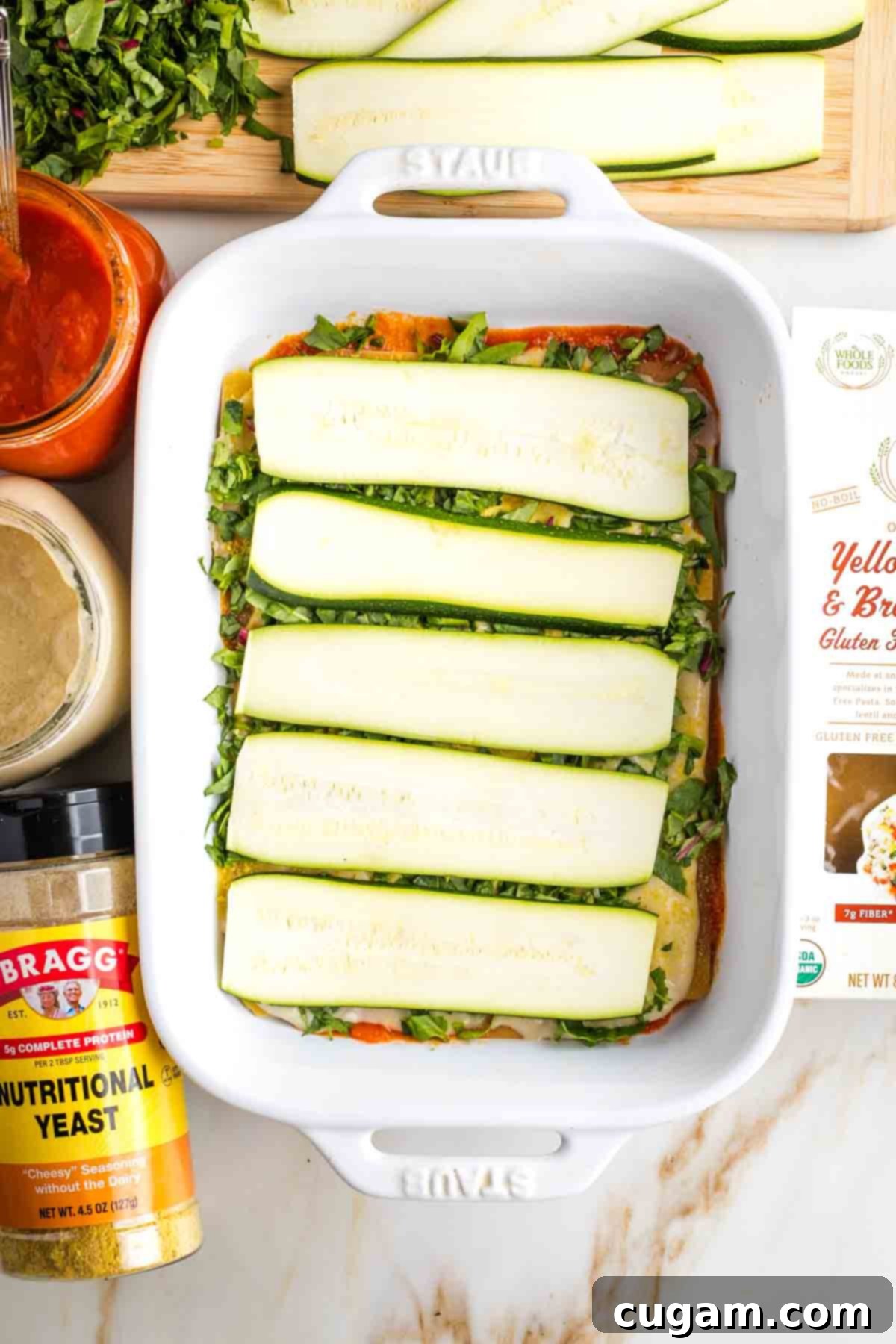
6. Arrange Zucchini Slices: Carefully lay out your thinly sliced zucchini (or yellow summer squash) across the entire length of the baking dish, creating an even layer. Overlap them slightly if necessary to cover the greens completely. The zucchini will soften beautifully in the oven, adding moisture and a delightful texture that complements the pasta.
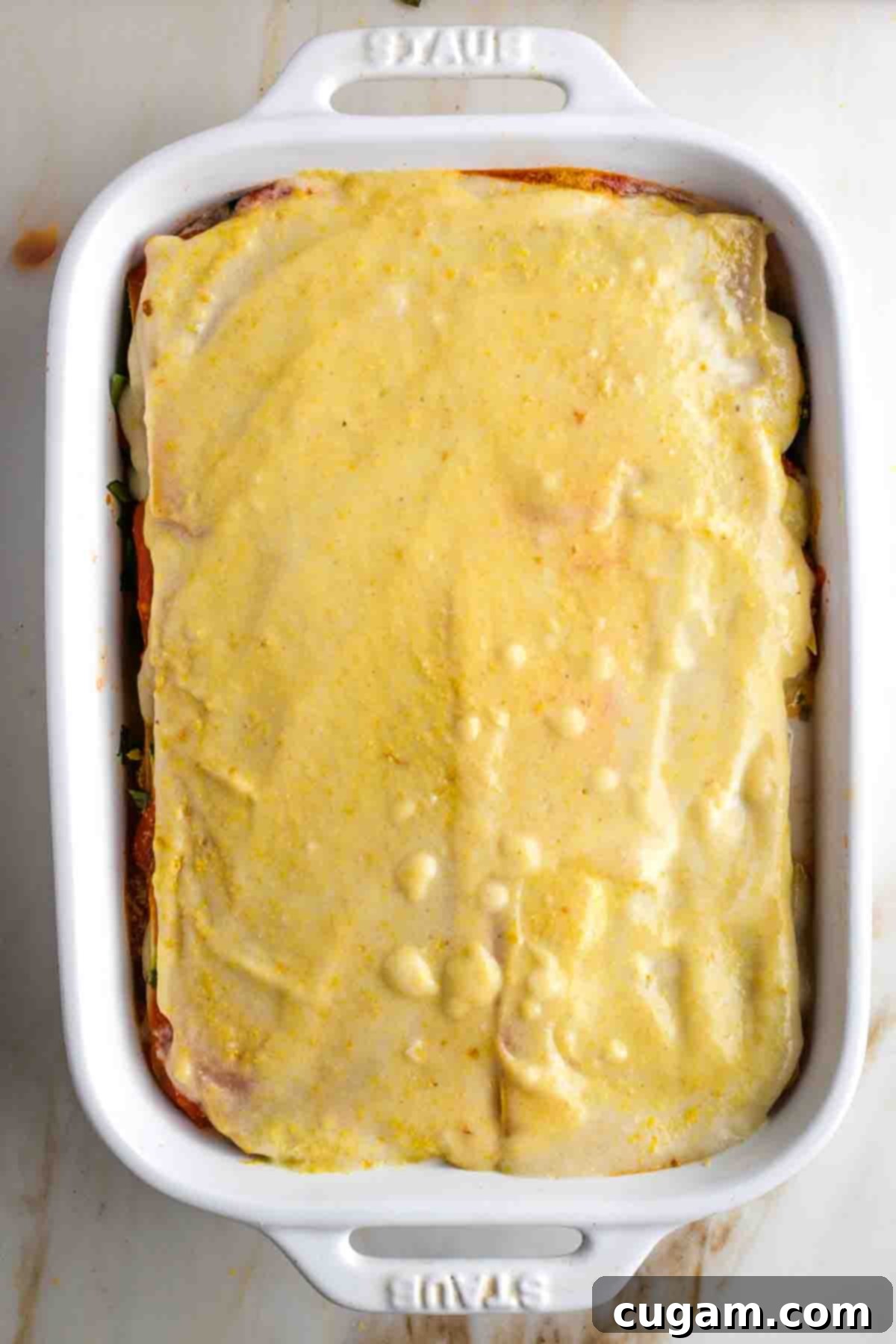
7. Continue Layering: Repeat the sequence: marinara sauce, uncooked pasta noodles, bechamel sauce, nutritional yeast, chopped greens, and zucchini slices. Continue building these delicious layers until all your ingredients have been used up and the baking dish is full. Aim to finish with a final layer of marinara and a generous sprinkle of nutritional yeast for a golden top.
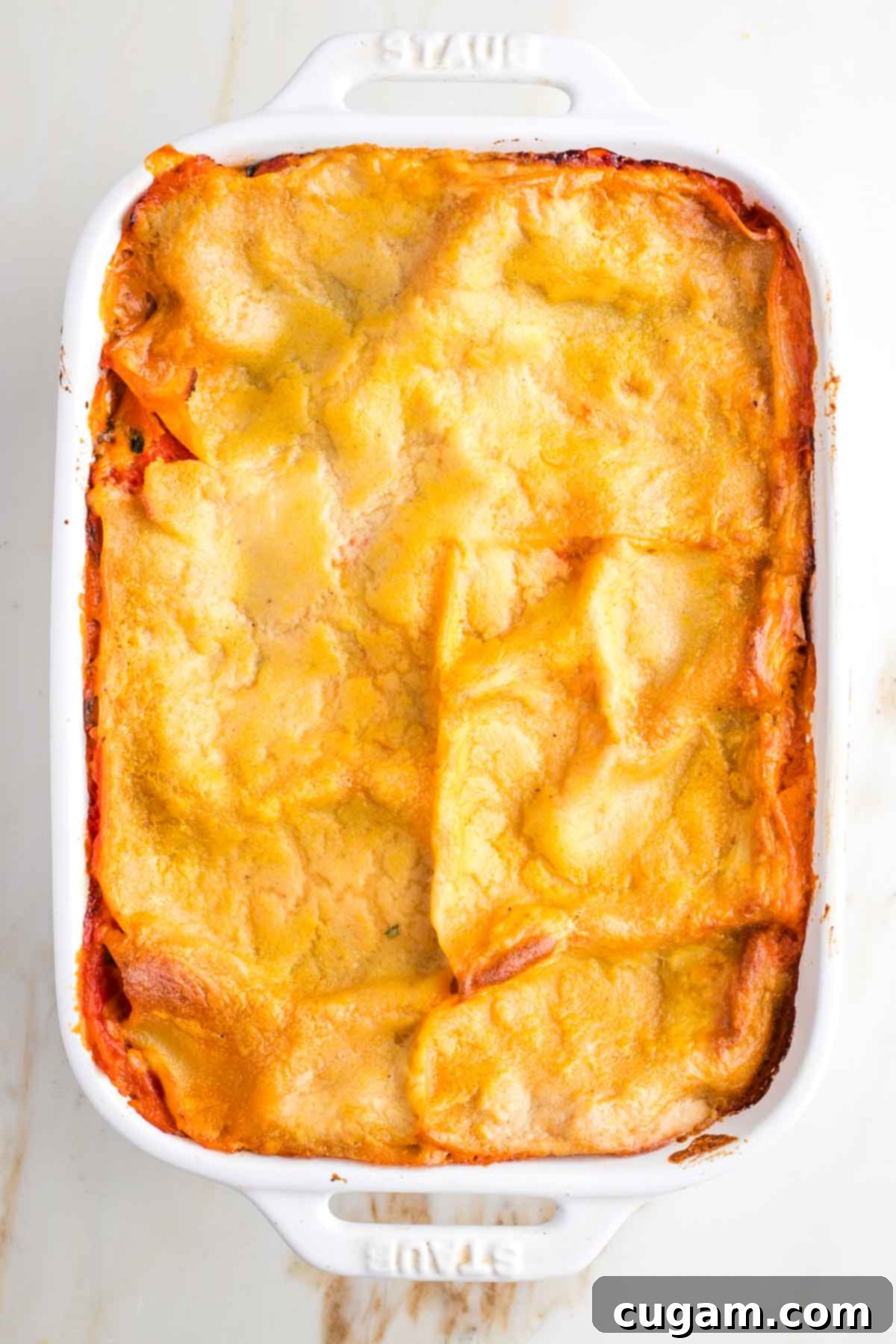
8. Bake to Perfection: Cover your lasagna dish loosely with foil and bake in a preheated 350°F (175°C) oven for a full 45 minutes. Resist the temptation to peek too early! The full baking time is crucial for the uncooked noodles and zucchini to become perfectly tender and for all the flavors to meld beautifully. You’ll know it’s ready when the sauce is bubbling invitingly around the edges.
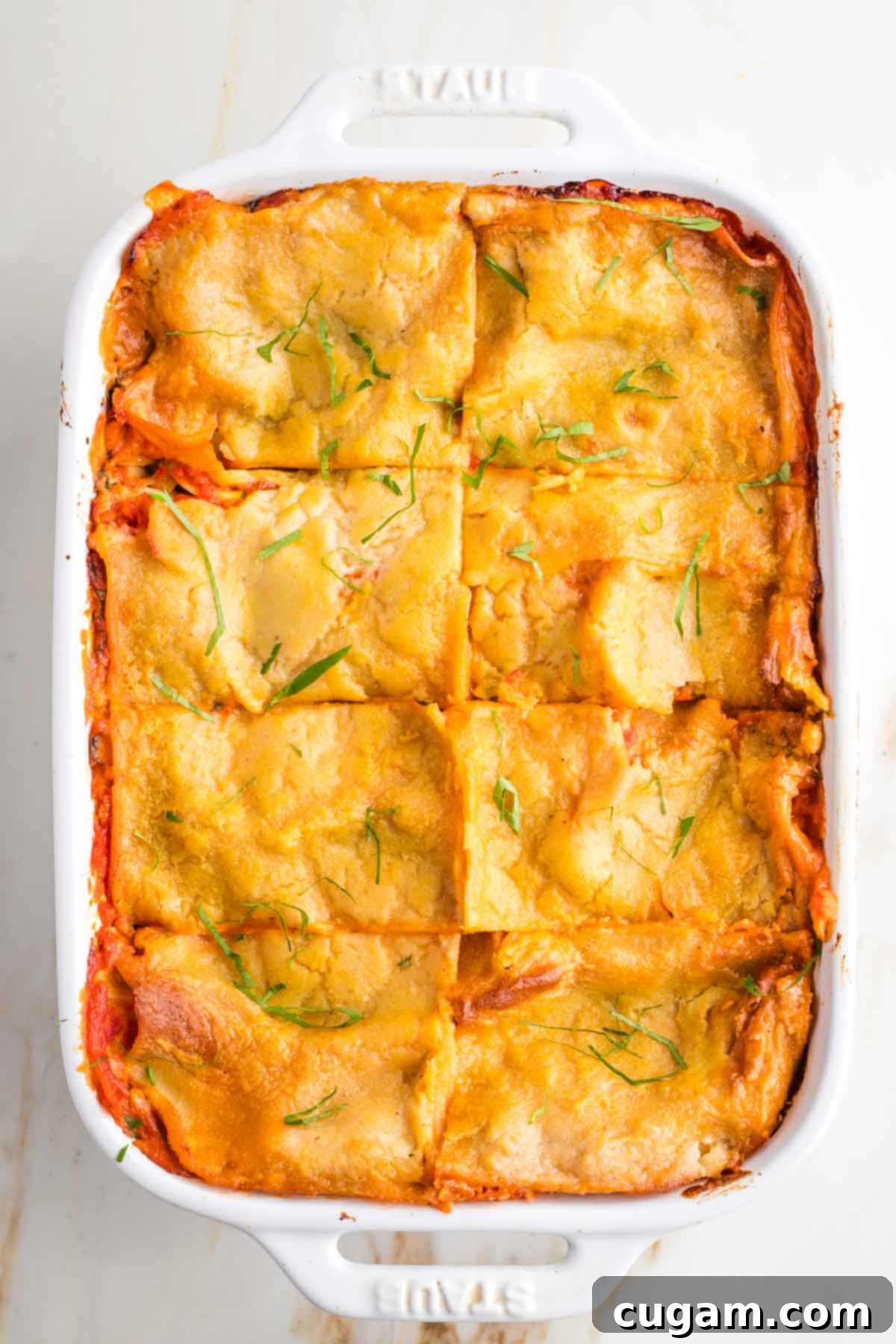
9. Rest and Serve: Once baked, remove the lasagna from the oven and let it rest for 10-15 minutes before slicing. This resting period allows the layers to set, making for cleaner cuts. Cut into 8 generous pieces and serve warm. For an extra touch of freshness and aroma, sprinkle with your favorite fresh herbs like basil, parsley, or oregano, if desired.
Debra’s Pro Tips for the Best Vegan Lasagna
Achieving a truly exceptional vegan and gluten-free lasagna is easier than you think with these expert tips:
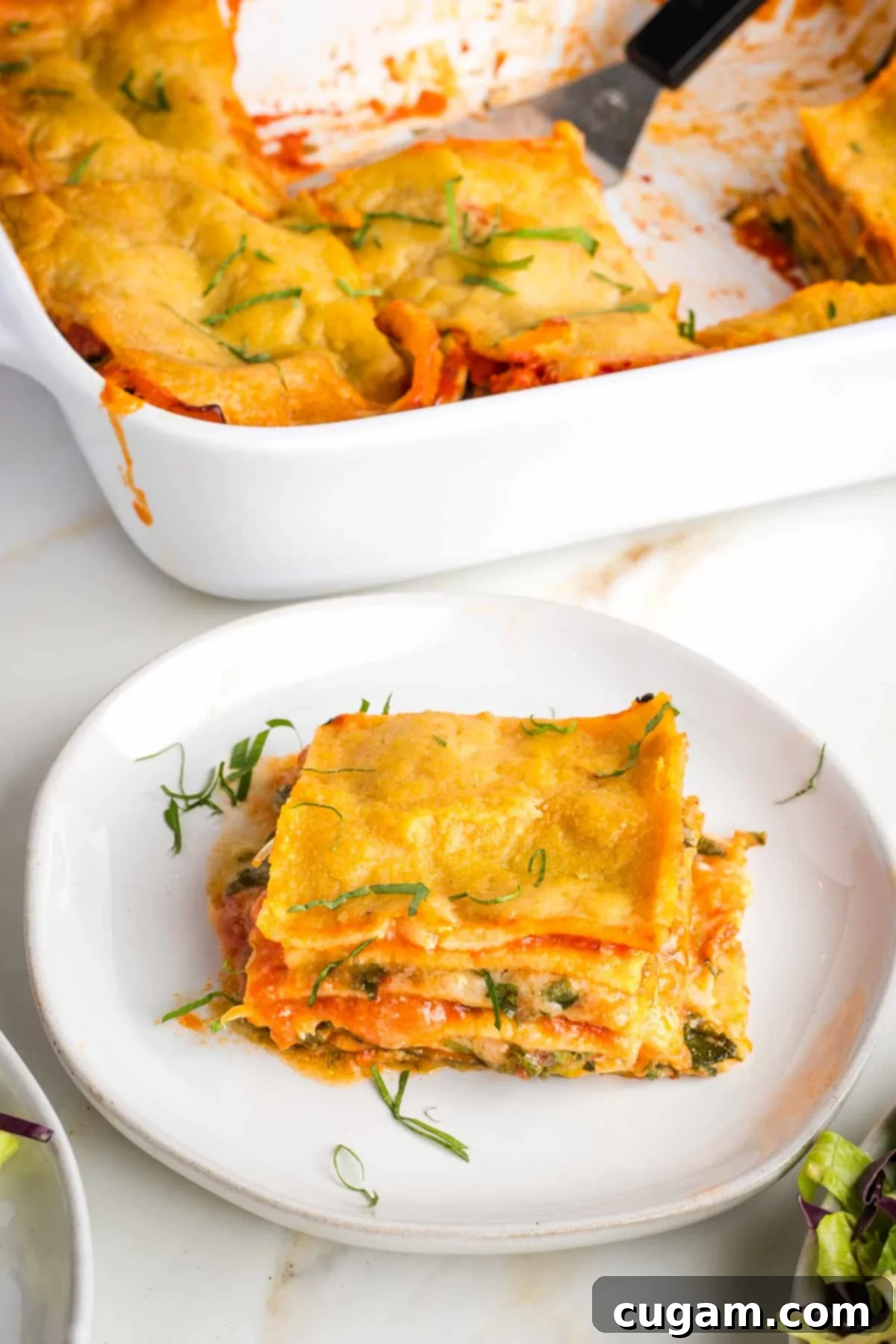
- Master the Bechamel in Advance: This is your ultimate time-saver! Preparing the dairy-free bechamel sauce up to 5 days before assembling the lasagna will cut your prep time on cooking day down to a mere 10 minutes. Having this creamy foundation ready allows for a stress-free assembly process, making this an ideal dish for busy weeknights or entertaining.
- Embrace Uncooked Gluten-Free Pasta: Conventional wisdom often dictates boiling lasagna noodles, but for gluten-free pasta, this can lead to a mushy texture. Trust the process with this recipe: layer your gluten-free lasagna noodles into the casserole *uncooked*. They will absorb moisture from the marinara and bechamel during baking, emerging perfectly al dente and retaining a satisfying bite, rather than dissolving into an overcooked mess.
- Zucchini: Your Secret Noodle Weapon: When thinly sliced, zucchini develops a delightful “bite” akin to a traditional lasagna noodle. It’s the perfect layering vegetable, adding freshness and nutrients without compromising texture. For an even lighter, low-carb version, or if you simply prefer more vegetables, you can absolutely omit the actual pasta noodles altogether and use thinly sliced zucchini as your sole noodle layer throughout the lasagna.
- Patience is Key for Baking: It can be tempting to pull the lasagna out of the oven early, especially when you see the sauces bubbling around the edges. However, resist this urge! The full 45 minutes of baking time is essential for both the gluten-free noodles and the zucchini slices to cook through completely and soften to the desired tender texture. Undercooking will result in firm pasta and crunchy zucchini.
- Transform it into a Classic White Lasagna: For a decadent and creamy alternative, create a classic vegan white lasagna. Simply omit the marinara sauce entirely and double the quantity of the dairy-free bechamel. This swap yields a rich, elegant dish with a different, yet equally delicious, flavor profile, highlighting the creaminess of the bechamel and the fresh vegetables.
Serving, Storing, and Reheating Your Vegan Lasagna
Maximize your enjoyment and minimize waste with these practical tips for serving, storing, and reheating your delicious vegan lasagna:
- Serving Suggestions: This hearty lasagna is a complete meal on its own, but it pairs beautifully with light, fresh sides. Consider serving it alongside a crisp simple green salad with a zesty vinaigrette, tender green beans almandine, or nutrient-packed oven-roasted broccoli. These accompaniments offer a refreshing contrast to the rich and savory lasagna.
- Storing Leftovers: Any leftover lasagna can be stored covered in the refrigerator for up to 5 days. Ensure it’s in an airtight container to maintain its freshness and prevent it from drying out or absorbing other odors from the fridge.
- Reheating Instructions: To reheat individual portions or the entire dish, place it in a 325°F (160°C) oven for 15-20 minutes, or until thoroughly heated through. Covering it loosely with foil during reheating can help prevent the top from becoming too crisp and ensures even heating. While a microwave can be used for convenience, oven reheating will better preserve the texture of the noodles and sauces.
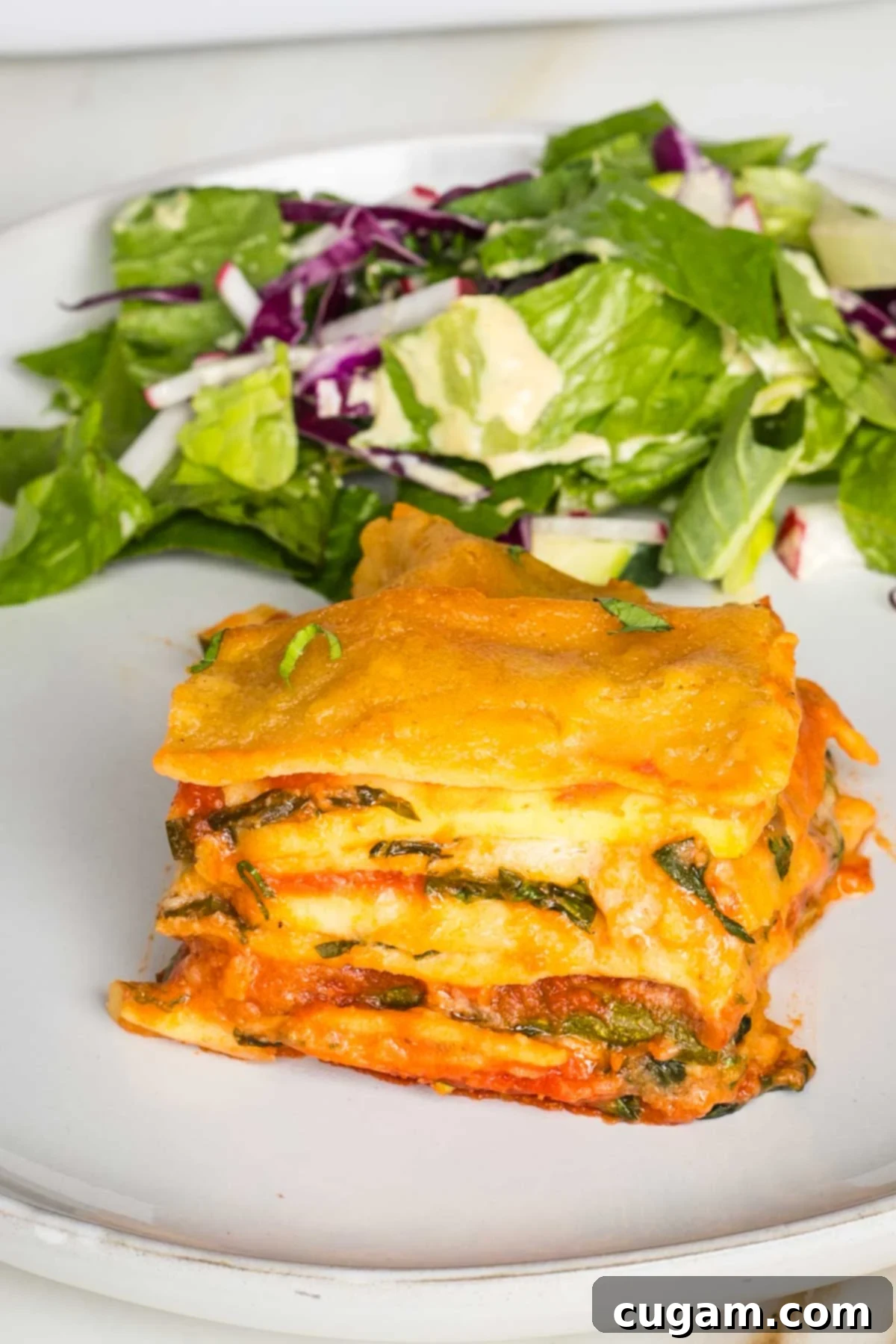
Did you know commenting and rating recipes is one of the best ways to support your favorite food bloggers? If you made this recipe, please consider a five-star rating below and leave a comment sharing your experience! Also, we’d love to see your creations on Instagram by tagging me @dkhealthcoach and using the hashtag #debraklein. Your feedback and shares mean the world!
📖 Recipe
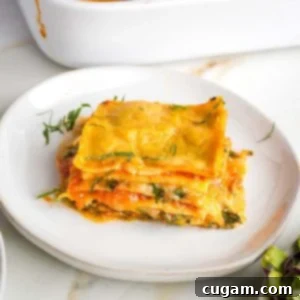
Hearty Veggie Lasagna with Creamy Dairy-Free Bechamel
Debra Klein
Rate this Recipe
Pin Recipe
15 minutes
45 minutes
1 hour
Main Course
Italian
8
125
kcal
Equipment
-
2 quart baking dish
-
Mandoline Slicer
Ingredients
-
2
cups
marinara sauce -
1
8-oz
package gluten-free lasagna noodles
uncooked -
2
cups
dairy-free bechamel sauce
-
3
cups
fresh baby spinach
finely chopped -
1
lb.
zucchini -
2
tablespoon
nutritional yeast
Dairy-free Bechamel Sauce (for approx. 2 cups)
-
¼
cup
olive oil -
¼
cup
cassava flour
-
2
cups
cashew milk -
½
tsp
sea salt -
¼
tsp
white pepper -
pinch
nutmeg -
1
tablespoon
light miso
Instructions
Make Bechamel Sauce
-
Heat the olive oil over medium-low heat in a small saucepan, allowing it to warm gently.
-
Whisk in the cassava flour immediately and cook for about 1-2 minutes to form a thick, pasty roux. Without delay, whisk in 2 tablespoons of cashew milk. Continue to add the remaining milk slowly, about ¼ cup at a time, whisking constantly and vigorously to prevent any lumps from forming. Each addition of milk will initially thin the sauce, but as it cooks gently, it will thicken back up to a creamy consistency.
-
Continue adding milk until about ¼ cup is left. Dilute the light miso paste into this remaining milk, stirring until smooth, then add this mixture to the sauce. Whisk and cook until the miso is fully incorporated and the sauce is thick enough to generously coat the back of a spoon.
-
Finally, stir in the sea salt, white pepper, and a pinch of nutmeg. Allow the sauce to cool completely before transferring it to an airtight jar or container and storing it in the refrigerator until you are ready to assemble your lasagna.
Assemble the Lasagna
-
Preheat your oven to 350°F (175°C). This ensures the oven is at the correct temperature for even baking once the lasagna is assembled.
-
Begin layering: Spoon ½ cup of marinara sauce onto the bottom of your baking dish. Top this with a single layer of uncooked gluten-free lasagna noodles. Over these noodles, spread ½ cup of the prepared dairy-free bechamel sauce. Next, sprinkle evenly with 2 teaspoons of nutritional yeast, followed by ½ cup of your finely chopped fresh greens, and finally, arrange a layer of thinly sliced zucchini.
-
Repeat the layers in the same order (marinara, pasta, bechamel, nutritional yeast, greens, zucchini) until all your ingredients have been used up and your baking dish is full. Ensure the final layer is a generous topping of bechamel and a sprinkle of nutritional yeast for a golden finish. Cover the dish loosely with foil and bake for the full 45 minutes. The lasagna will be bubbling vigorously around the edges, and both the noodles and zucchini will be tender and perfectly cooked.
-
Once baked, remove from the oven and allow the lasagna to rest for 10-15 minutes before slicing. This resting time helps the layers set, making it easier to cut into 8 neat pieces. Serve warm and enjoy your homemade vegan delight!
Notes
Lasagna Noodles: Use a high-quality gluten-free lasagna noodle brand that you trust and that fits your specific dietary needs. Nutritional information, especially for carbohydrates and calories, will naturally vary significantly by brand and type of noodle. It’s crucial to remember that whether you choose “no-boil” or regular gluten-free lasagna noodles, there is absolutely no need to pre-cook them before layering them into the lasagna. They will become perfectly tender and al dente during the baking process by absorbing moisture from the delicious sauces.
Bechamel Sauce: For detailed, step-by-step directions on how to make the dairy-free bechamel sauce from scratch, including various ingredient substitutions (such as different plant-based milks or flours), please refer to my comprehensive and easy-to-follow recipe for dairy-free bechamel. This dedicated post offers additional insights and tips to ensure your sauce is perfect every time.
Nutrition
Calories:
125
kcal
Carbohydrates:
11
g
Protein:
3
g
Fat:
8
g
Saturated Fat:
1
g
Polyunsaturated Fat:
1
g
Monounsaturated Fat:
5
g
Sodium:
609
mg
Potassium:
435
mg
Fiber:
2
g
Sugar:
4
g
Vitamin A:
1435
IU
Vitamin C:
18
mg
Calcium:
32
mg
Iron:
1
mg
Note
The nutrition calculations provided were performed using online tools and are intended as an estimate. To obtain the most accurate representation of the nutritional information for any given recipe, it is always recommended that you calculate the nutritional information with the actual ingredients and brands you personally used. You are ultimately responsible for ensuring that any nutritional information you rely upon is accurate, complete, and useful for your specific dietary needs.
Did you make this recipe?
Please leave a review below, then snap a picture and tag me @dkhealthcoach or use hashtag #dkhealtcoach on Instagram so I can see it!!
